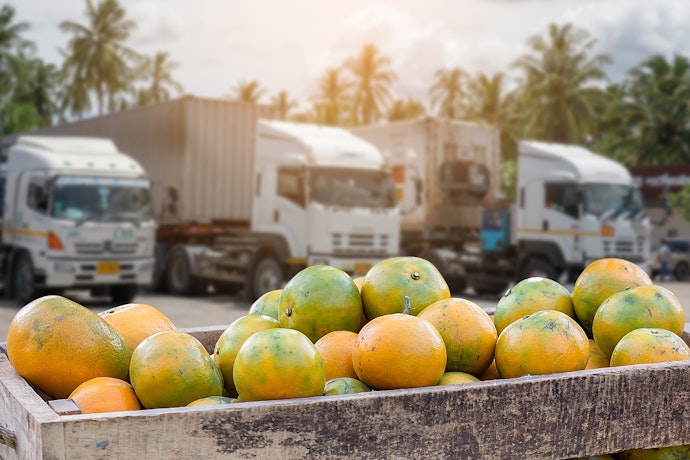How to Reduce Your Expenses
As a fleet owner, your day-to-day costs can quickly add up. What you don’t know is there are further hidden, expensive...
Read more
The cold chain industry is growing rapidly—the market size of the global cold chain was valued at 220 billion AUD in 2018 and is expected to expand at a CAGR of 15.1% by 2025. This growth is fueled by the expansion of connected devices and automation within the industry, increased demand for perishable food products, the ongoing trend of purchasing these products online and the rising expectations consumers have for faster-than-ever delivery.
It has been predicted that the Australian cold chain logistics market will show an annual growth rate of about 3% during 2020-2025. The country is one of the largest players when it comes to producing and exporting perishable goods therefore it is imperative that it is done correctly. Goods for export must comply with any controls and requirements specified in the Export Control Act 1982.
The ‘cold chain’ includes refrigerated production, storage, and distribution. It not only requires specialised equipment such as temperature-controlled trailers (also known as ‘reefers’) to function, but a cold chain also relies on a series of refrigerated activities to constantly keep products at the correct low-temperature range. This makes it a complicated industry for shippers and trucking companies alike, not least because one contributing factor for food illness and waste is poor cold chain management. It has been estimated that contaminated food causes approximately 5.4 million cases of gastroenteritis annually in Australia. Australians also throw away around $5.2 billion of food a year, including more than $1.1 billion worth of fruit and vegetables and $872.5 million worth of fresh meat and fish.
Cold chain management, however, isn’t just reserved for food, it is also indispensable for Covid-19 vaccine distribution. For example, Pfizer-BioNTech has to be kept frozen between -80ºC to -60ºC and protected from light until it’s ready to use.4 For trucking fleets carrying vaccine shipments, maintaining the cold chain, and ensuring proper monitoring and tracking of refrigerated trailers, is crucial to transport success.
Demands and expectations faced by cold chain providers
This host of demands is putting the heat on cold chain logistics providers and distributors to promote efficiency, speed delivery, and ensure product integrity. Rising consumer expectations for fresher, healthier food means decreased processing, shorter shelf life and increased temperature sensitivity. Many pharmaceutical and biotechnology products now involve more high-value, active ingredients with shorter shelf lives and a wider range of controlled temperature requirements. This not only requires more transporting versatility and vigilance to promote quality and safety—it also substantially increases the cost of a ruined shipment.
At the same time, cold chain operators face the same challenges confronting the supply chain as a whole, including truck driver and capacity shortages, and placing an increased emphasis on meeting sustainability goals. These challenges can have a particularly big impact on a refrigerated fleet, which requires capital-intensive investment, specially trained drivers, and substantial energy consumption, and involves increased liability and heightened inspection risk.
Integrated GPS asset tracking technology for trailers helps cold chain logistics providers and distributors tackle these challenges head-on. By providing near-real time visibility for trailers and other assets, near-real time monitoring of temperature and other key metrics, and on-demand communication with truck drivers, asset tracking solutions boost cold chain efficiency, delivery speed, and product safety for the long haul.
By quickly and easily installing small, mountable GPS sensors, it’s possible to seamlessly monitor and track trailers and other assets critical to cold chain operations via a laptop, tablet, or smartphone.
Using sensors to monitor trailer temperatures helps carriers accomplish the following:
Here are six ways these solutions deliver temperature-sensitive products where they need to go, safely and efficiently:
1. Gain better visibility.
The cornerstone of cold chain management efficiency is information. You need to know where your trailers and other assets are and where they’ve been. An asset tracking solution gives you full asset visibility in near real-time, including location, current status and usage history.
Whether you have dozens, hundreds, or thousands of powered or non-powered assets of various makes, models, and manufacturers, you can track them on a single web-based dashboard that consolidates data, clusters multiple assets, and offers fast searching or tag filtering. That means you can easily locate the closest available trailer for the right job.
Asset tracking is more than knowing where your trailers are—it’s knowing how they’re doing on a broad range of key indicators. Using status updates and automated alerts, fleet managers can monitor temperature data, reefer status, door closure and movement, excessive vibration, intrusion and more. If temperatures move out of safe ranges, you can take immediate action.
Asset tracking software reveals how often your trailers and other assets are being used—or sitting idle—across geographic locations. The ability to identify equipment with low ROI helps you make informed decisions about renting or selling underperforming assets or whether you should deploy them elsewhere. Utilisation software can also use precise metrics to determine how often and how long cold chain equipment ran during a certain time period.
Tracking solutions enable you to automate geofence alerts when a shipment nears your customer’s loading dock. When a trailer is delivered, the cargo can be unloaded quickly and moved to its next temperature-controlled location, maintaining product safety and integrity. Create a virtual perimeter for added security around trailers or cargo that triggers an alert when they move from an approved location.
GPS fleet tracking means you can keep in touch with your drivers at any time, helping them find the fastest route, and reducing unnecessary or unauthorised stops. You can also monitor driver behaviour, such as harsh braking, excessive acceleration, and speeding, which can pose a danger to others, as well as add costly wear and tear to equipment.
Set automated alerts for necessary maintenance and inspections, helping you to comply with all regulations and improve equipment safety, as well as helping to prevent costly breakdowns and extend the life of your assets.
Make sure to select an intuitive, comprehensive solution that matches your cold chain delivery needs and helps you deliver the speed and efficiency your customers expect. Features to look for include:
Tags: Cost Control, Customer Service, Dispatching & Scheduling, Field Management, Productivity & Efficiency, Safety, Vehicle Maintenance, Vehicle & Asset Security




Find out how our platform gives you the visibility you need to get more done.
As a fleet owner, your day-to-day costs can quickly add up. What you don’t know is there are further hidden, expensive...
Read moreWith the many choices of GPS tracking software out there, how do you decide which one is best for your fleet business?...
Read moreMichael Chester founded Sun City Plumbing in Geraldton, in 2000. Since, the company has grown from three to 70 employees...
Read more